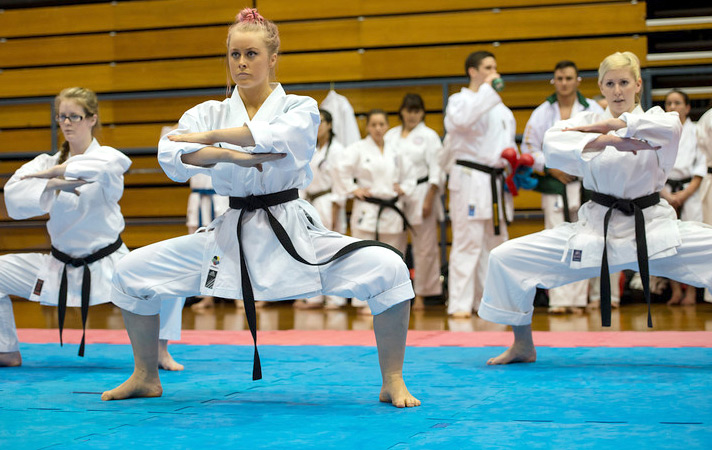Why Kata is an Integral Part of Karate
There are numerous reasons why kata is such an integral part of karate, Shihan Anthony Ryan explains them below:
1. Kata Is the Art Form of Karate
Without kata, most styles would be virtually the same – a series of punching and kicking techniques. Kata represents the ‘art’ or ‘culture’ of a style providing a direct link to the past by studying the techniques and principles practiced by karate’s forefathers. By observing a style’s Kata, one can also gain insight into some of a style’s philosophies and, as a student practicing kata, become a moving breathing example of the art itself. In this way, kata almost becomes the signature of an art.
Perhaps the reason kata is associated with karate’s art form is because it is a work of art. While there is no clay to mold, the practitioner is the clay, and their endeavor is to master their body and mold themselves into an incredibly moving sculpture. This may sound over the top but is not far from the truth. Kata is an art that when mastered can appear deadly, yet beautiful. It can appear powerful, yet soft; explosive, yet flowing. When Kata is not mastered, it appears nothing like art and no more than a sequence of abstract fighting techniques or calisthenic exercises.
When Kata is performed properly, like any piece of art, you can see the heart of the person performing it. Like any piece of art, you can see the emotion yet equally, self-control over this emotion. When it is not performed properly it appears empty or over-emotional. When Kata is performed properly, the practitioner appears to be fighting an imaginary opponent. It appears powerful but effortless. When it is not, the practitioner appears to be fighting their own body, their own energies.
This is made apparent when a person is completely worn out after performing just one kata with intensity.
Many warriors throughout the history of the world fascinated themselves with art. For example, it was expected that the great warriors in Spain would also be expert dancers (ballroom dancers). This showed they were masters of their craft, men with culture and finesse, not just ‘men who bore arms’. Many tribal warriors throughout the world not only engaged in dances the evening before the battle, but painted beautiful works of art on their skin beforehand. And most notably, the famous Samurai warriors of Japan often practiced calligraphy for hours on end trying to perfect their technique.
Having art is integral to any martial art for it acts to restore balance. Training in a fighting art generates aggressive qualities (essential for self-defence). However, developing these qualities without balance leads to an aggressive nature.
When we again look back into history, the warriors of Spain and Japan were also famous for being loving fathers and husbands. The art and culture that was endorsed to them helped them to keep balance. While their fighting art trained them to be fierce warriors, the arts helped them maintain self-control and inner harmony. This meant they were also cunning and emotion-controlled warriors, but away from a battle, could be highly respected and noble citizens.
The warriors of other countries who often painted their faces and bodies and danced before battle were also noted as having loving qualities. In many respects, the face painting was about creating a mask and symbolised an alter ego being created solely for battle. This way they could be two people, a warrior and a citizen, but both were different people so one did not disrupt the life of the other.
In comparison, countries throughout history whose warriors trained in fighting arts without any promotion of art or culture often struggled to keep balance, unable to separate the warrior from the man. Away from battle, warriors would often take women against their will, were rude and obnoxious and often misused their skills. They also failed to fit into society, something many war veterans feel from the more modern wars.
2. Kata Teaches Self-Defence
As well as an art form, Kata is also a form of self-defence training. Commonly described as a fight scene against imaginary attackers, each technique or combination of techniques within a kata has a Bunkai (application) based on a self-defence scenario. At times the self-defence applications are easily recognised, while some require slight explanation before becoming apparent.
What has frustrated those unappreciative of kata and led to their labeling it as no more than an art form and an ineffective means of self-defence, is the fact that many kata applications are very abstract, while others required ‘added’ techniques (like a jigsaw) before the technique becomes ‘effective’ and apparent. There are three major influences behind kata having a sense of ‘mystery that needs to be unlocked’.
Firstly, and perhaps the most understandable, is that karate’s forefathers originally created kata with deliberate intention to conceal their self-defence application. This served to prevent casual observers or those who were not serious about learning all things involved with karate (such as the time it takes to develop humility etc) from learning potentially deadly techniques.
The second major influence came in 1901 when Master Yasutsune Itosu introduced karate into the Japanese school system. He believed that kata was too dangerous to be taught to young children so he set about disguising many of the techniques inside.
The third major influence came due to the fact that kata mostly dealt with defence from being grappled and as such, contained numerous highly effective techniques such as eye-gouging, throat grabbing, groin squeezing etc. These techniques were known as entrance techniques. However when karate arrived from Okinawa, the Japanese believed it to be ‘too violent’, therefore resulting in a number of these entrance techniques being removed. Understanding that kata had a number of these entrance techniques removed helps to illuminate the real potential of kata. For example: When studying bunkai, a person will discover that almost all kata have a number of defences against a ‘wrist grab’. Again, some kata critics make a point that it is extremely rare for an attacker to start by grabbing their victim’s wrist.
What must be understood however, is that if our first reaction were an entrance technique (such as the seizing the attacker’s eyes, throat or groin), their likely reaction would be to try and remove your grip (hence grabbing your wrist). From this position it suddenly becomes apparent the advantage of knowing a number of ways to either remove or reverse a wrist grab. Equally, by understanding that the attacker has not just grabbed your wrist for no reason, and that the philosophy is for you to have control, or part control of one of their vital areas, the attacker will have less strength in their arm, making it believable that a weaker person could execute the technique effectively.
By understanding, and even visualizing the Bunkai (application) of the techniques while performing kata, practitioners equip themselves for a self-defence situation by:
- They gain insight into various defenses against numerous situations (defence against both striking and grappling attacks).
- They gain muscle memory of how to move when fighting numerous attackers (such as changing between stances to remain balanced and strong and changing angles).
- It trains a person to execute their techniques with full spirit and Kime. To land their techniques perfectly without fear of hurting their opponent (sparring often fails to endorse this).
Some practitioners proclaim that sparring is modern karate’s best training for self-defence. While it is absolute that sparring is important for self-defence training by developing timing, distance and a familiarity with the mental and physical ramifications of being attacked, all practitioners are limited without kata training. This is because sparring follows a set of rules, a designated distance and rarely involves being grappled or surprised.
3. Kata Promotes Self-mastery
Is kata entirely essential? A tool for developing self-defence skills and ideologies? Karate’s art, and an historical link to its past? It could be proposed that each of these could be developed by numerous means. Students can, and do learn self-defence during basics, sparring and specific self- defence drills. And the history of karate can be preserved through studying its history. So perhaps the most potent tool that kata equips a student with, is the pursuit of self- mastery. Great emphasis is placed upon the perfection of every aspect of kata, including correct form, breathing, focus, balance and they are designed to perfect the grace, consciousness, and power of the physical self and spirit.
All karate-ka would agree that irrespective of their development, there is always something they need to improve upon, even if only to fine tune every kata they practice. And it is this attitude of self- mastery that is most essential, for without it, all else suffers.
In terms of kata as an art form, any fine artwork is flawless. Consider again that a kata practitioner is like a piece of clay and must mould their kata into an incredible moving sculpture. A practitioner who has no focus towards perfection will never develop a great kata. In terms of self- defence, considering that a self-defence situation can be unpredictable and emotion driven, coming up with highly effective techniques under stress will be difficult for the practitioner who has not developed a focus towards perfection.
Before any technique can be mastered, one must master themselves. Knowing exactly ‘how’ a technique or combination of techniques must be performed can be very different to actually ‘doing’ it. To develop a powerful, well-balanced strike, block or throw, the entire body must work in unison. By practicing kata with the pursuit of perfection, we develop our mind and body connection. Developing this connection is more difficult during basic training as techniques are more often practiced individually while kata involves a series of techniques bound together in a sequential timing.
Getting every movement correct in both timing and technique requires mastery over our entire body, but one cannot master their physical selves until they have mastered their thoughts. Completing an entire kata ‘properly’ so that it is not only representative of the art of Go-Kan-Ryu but also viable as a means of self-defence, requires one to have mastered their thoughts.
A few examples highlighting a lack of self-mastery of the mind are:
Distraction: Being unable to perform a kata beginning to end without being distracted sounds easy but can prove difficult. It often arises when a mistake in technique occurs and the practitioner remains focused on the error rather than mentally moving on.
Nerves: Especially when performing solo, being unable to control one’s nerves causes a person to rush and make vital errors.
Over-effort: Again, especially when performing solo in their attempt to be powerful, a practitioner may put too much effort into techniques. This actually detracts from their power output, slows them down and produces telegraphed movements. It is essential that a student allow the proper technique to provide their power.
Each of the above is not only essential in the unlikely event of a self-defence situation, but in our everyday lives. There will be many times in our lives that the ability to control these emotions and others can pay massive dividends. When we can master our minds, we can master our bodies and our entire world.
Why The Same Kata Can Appear Different?
While most traditional karate styles study a similar kata curriculum, each style will have small differences, its own unique interpretation or method of delivering a technique. Some argue this should never occur and endeavor to find the ‘purest’ form of the Kata so it may be practiced the way it was first intended.
While this would be ideal, original teachings in Okinawa were never written down and many records died with their creators. Furthermore, when some of the top students of the original masters ventured out and taught for themselves – while maintaining the core of the Kata – they made slight adjustments based on their own personal philosophy and educated opinion of a technique.
In the same manner, when their students moved on and taught the same happened again. Even if you visit the top masters in Japan today you will notice that their students will practice kata differently, or associate a different Bunkai (application) to the techniques. Were you to visit Okinawa (the birthplace of karate), you will find the differences even more prevalent.




